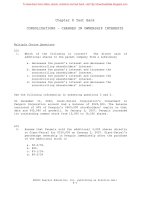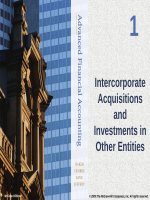Advanced financial accounting by baker chapter 08
Bạn đang xem bản rút gọn của tài liệu. Xem và tải ngay bản đầy đủ của tài liệu tại đây (3.31 MB, 39 trang )
8
Intercompany
Indebtedness
McGraw-Hill/Irwin
© 2009 The McGraw-Hill Companies, Inc. All rights reserved.
Consolidation Overview
• A direct intercompany debt transfer involves
a loan from one affiliate to another without
the participation of an unrelated party
• An indirect intercompany debt transfer
involves the issuance of debt to an unrelated
party and the subsequent purchase of the
debt instrument by an affiliate of the issuer
8-2
Consolidation Overview
8-3
Consolidation Overview
8-4
Bond Sale Directly to an Affiliate
• When one company sells bonds directly to an
affiliate, all effects of the intercompany
indebtedness must be eliminated in
preparing consolidated financial statements
• Transfer at par value
Assume that on January 1, 20X1, Special Foods borrows $100,000 from
Peerless Products by issuing $100,000 par value, 12 percent, 10-year
bonds. During 20X1, Special Foods records interest expense on the bonds
of $12,000 ($100,000 x .12), and Peerless records an equal amount of
interest income.
8-5
Bond Sale Directly to an Affiliate
In the preparation of consolidated financial statements for 20X1, two
elimination entries are needed in the consolidation workpaper to remove
the effects of the intercompany indebtedness:
These entries have no effect on consolidated net income because they reduce
interest income and interest expense by the same amount.
8-6
Bond Sale Directly to an Affiliate
• Transfer at a discount or premium
– Bond interest income or expense recorded do
not equal cash interest payments
– Interest income/ expense amounts are adjusted
for the amortization of the discount or premium
On January 1, 20X1, Peerless Products purchases $100,000 par value, 12
percent, 10-year bonds from Special Foods for $90,000. Interest on the
bonds is payable on January 1 and July 1. The interest expense
recognized by Special Foods and the interest income recognized by
Peerless each year include straight-line amortization of the discount, as
follows:
8-7
Bond Sale Directly to an Affiliate
• Entries by the debtor
8-8
Bond Sale Directly to an Affiliate
• Entries by the bond investor
8-9
Bond Sale Directly to an Affiliate
Entry E(9) eliminates the bonds payable and associated discount against the
investment in bonds.
Entry E(10) eliminates the bond interest income recognized by Peerless
during 20X1 against the bond interest expense recognized by Special
Foods.
Entry E(11) eliminates the interest receivable against the interest payable.
8-10
Bond Sale Directly to an Affiliate
Consolidation at the end of 20X2 requires elimination entries similar to those
at the end of 20X1.
Because $1,000 of the discount is amortized each year, the bond investment
balance on Peerless’s books increases to $92,000.
8-11
Bonds of Affiliate Purchased from a
Nonaffiliate
• Scenario: Bonds that were issued to an unrelated
party are acquired later by an affiliate of the issuer
– From the viewpoint of the consolidated entity, an
acquisition of an affiliate’s bonds retires the bonds at the
time they are purchased
• Acquisition of the bonds of an affiliate by another
company within the consolidated entity is referred to
as constructive retirement
– Although the bonds actually are not retired, they are
treated as if they were retired in preparing consolidated
financial statements
8-12
Bonds of Affiliate Purchased from a
Nonaffiliate
• When a constructive retirement occurs:
– The consolidated income statement for the
period reports a gain or loss on debt retirement
based on the difference between the carrying
value of the bonds on the books of the debtor
and the purchase price paid by the affiliate
– Neither the bonds payable nor the purchaser’s
investment in the bonds is reported in the
consolidated balance sheet because the bonds
are no longer considered outstanding
8-13
Bonds of Affiliate Purchased from a
Nonaffiliate
• Purchase at book value
– Elimination entries are identical to those used in
eliminating a direct intercorporate debt transfer
– The total of the bond liability and the related
premium/ discount reported by the debtor equal
the balance in the investment account shown
by the bondholder, and the interest income
reported by the bondholder each period equals
the interest expense reported by the debtor
– All of these amounts need to be eliminated
8-14
Bonds of Affiliate Purchased from a
Nonaffiliate
• Purchase at an amount less than book value
– When the price paid to acquire the bonds of an affiliate
differs from the liability reported by the debtor, a gain or
loss is reported in the consolidated income statement in
the period of constructive retirement
– The bond interest income and interest expense reported
by the two affiliates subsequent to the purchase must be
eliminated in preparing consolidated statements
– Interest income reported by the investing affiliate and
interest expense reported by the debtor are not equal in
this case because of the different bond carrying
amounts on the books of the two companies
8-15
Bonds of Affiliate Purchased from a
Nonaffiliate - Illustration
Peerless Products Corporation acquires 80 percent of the common stock of
Special Foods Inc. on December 31, 20X0, for its underlying book value of
$240,000. At that date, the fair value of the noncontrolling interest is equal
to its book value of $60,000. Additionally:
1. On January 1, 20X1, Special Foods issues 10-year, 12 percent bonds
payable with a par value of $100,000; the bonds are issued at 102.
Nonaffiliated Corporation purchases the bonds from Special Foods.
2. The bonds pay interest on June 30 and December 31.
3. Both Peerless and Special amortize bond discount and premium using the
straight-line method.
4. On December 31, 20X1, Peerless purchases the bonds from Nonaffiliated for
$91,000.
5. Special Foods reports net income of $50,000 for 20X1 and $75,000 for 20X2
and declares dividends of $30,000 in 20X1 and $40,000 in 20X2.
6. Peerless earns $140,000 in 20X1 and $160,000 in 20X2 from its own
separate operations. Peerless declares dividends of $60,000 in both 20X1 ]
and 20X2.
8-16
Bonds of Affiliate Purchased from a
Nonaffiliate - Illustration
8-17
Bonds of Affiliate Purchased from a
Nonaffiliate - Illustration
8-18
Bonds of Affiliate Purchased from a
Nonaffiliate - Illustration
This gain is included in the consolidated income statement as a gain on the
retirement of bonds.
8-19
Bonds of Affiliate Purchased from a
Nonaffiliate - Illustration
•
Assignment of gain - constructive retirement
– Four approaches have been used:
1.
2.
3.
4.
The affiliate issuing the bonds
The affiliate purchasing the bonds
The parent company
The issuing and purchasing companies, based
on the difference between the carrying amounts
of the bonds on their books at the date of
purchase and the par value of the bonds
8-20
Bonds of Affiliate Purchased from a
Nonaffiliate - Illustration
Peerless also records the normal basic equity-method entries during 20X1. The December 31,
20X1, workpaper to prepare consolidated financial statements for Peerless and Special
Foods is presented in Figure 8–2 in the text. Eliminating entries:
8-21
Bonds of Affiliate Purchased from a
Nonaffiliate - Illustration
• Consolidated Net Income—20X1
• Noncontrolling Interest—December 31, 20X1
8-22
Bonds of Affiliate Purchased from a
Nonaffiliate - Illustration
8-23
Bonds of Affiliate Purchased from a
Nonaffiliate - Illustration
• Subsequent recognition of gain on
constructive retirement
– In 20X1, the entire $10,800 gain on the
retirement was recognized in the consolidated
income statement but not on the books of either
Peerless or Special Foods
8-24
Bonds of Affiliate Purchased from a
Nonaffiliate - Illustration
– This can be visualized as in the following figure:
8-25









